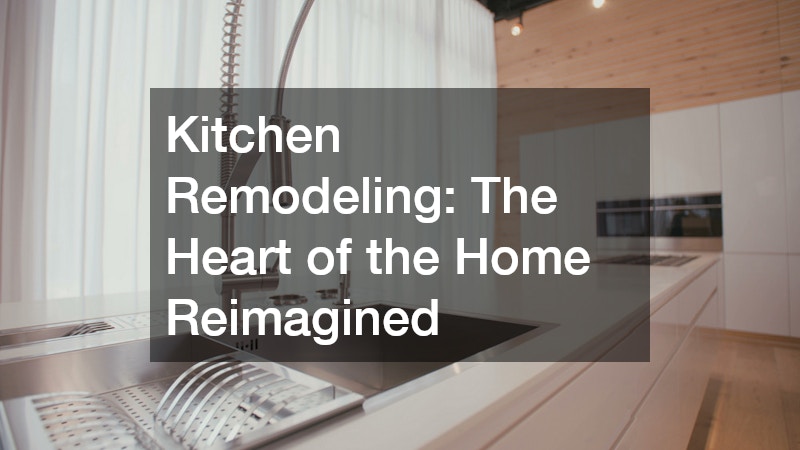Kitchen Remodeling: The Heart of the Home Reimagined
Introduction
The kitchen is often referred to as the heart of the home. As lifestyles evolve and design trends change, many homeowners are considering kitchen remodeling to create a space that suits their needs and aesthetic preferences. In this article, we will address some of the most common questions and concerns about kitchen remodeling, providing insights and tips for a successful transformation.
1. What Is the Best Layout for Kitchen Remodeling?
A. Understanding Different Kitchen Layouts
The layout of your kitchen can significantly impact its functionality and flow. Traditional layouts include L-shaped, U-shaped, galley, and open-plan designs, each offering unique benefits and challenges.
Understanding these different layouts allows homeowners to make informed decisions about which one best suits their space and lifestyle needs.
For instance, an L-shaped kitchen offers a compact yet versatile layout that is ideal for small to medium-sized spaces. In contrast, an open-plan kitchen is perfect for those who love entertaining and want their kitchen to seamlessly integrate with the dining or living area. Consequently, choosing the right layout involves assessing the size, shape, and accessibility of your kitchen space.
It’s also essential to factor in technological integration, which can influence layout choices. Smart appliances and innovative storage solutions can effectively be included in any layout, given proper planning. Ultimately, the best kitchen layout is one that complements daily routines and enhances the overall kitchen experience.
B. Assessing Your Space and Needs
Before settling on a layout, it’s crucial to assess the available space and your specific needs. Measure the dimensions of your kitchen, including countertops, wall lengths, and existing cabinets, to determine what changes are feasible. Consider how you use your kitchen—whether you prioritize cooking, socializing, or a mix of both—this will guide your layout decisions profoundly.
A practical approach is to list all the functions your kitchen must support. Do you need more counter space for cooking, or is additional dining space a priority? Understanding these needs will help identify the critical features to include in your redesigned kitchen space.
Space assessment should also include lighting needs, as they can affect kitchen usability. Well-lit kitchen spaces enhance safety and ambiance, so ensure your design accommodates natural and artificial lighting opportunities. Evaluating these factors thoroughly will lead to a more successful kitchen remodeling project, tailored precisely to your needs.
2. How Do I Choose the Right Materials for My Kitchen Remodel?
A. Overview of Popular Kitchen Materials
Choosing materials for your kitchen remodel is a vital aspect that influences aesthetics, durability, and overall functionality. Popular materials include granite and quartz for countertops, which offer durability and a luxurious appearance. Additionally, wood and stainless steel remain favored choices for cabinetry and appliances, respectively, adding warmth and sleekness to the kitchen.
Tiles, available in myriad designs and finishes, serve both functional and decorative purposes, suitable for flooring and backsplash installations. Modern materials like engineered stone and recycled composites are becoming increasingly popular for their customizable features and environmental benefits. Such diverse options allow homeowners to find materials that align with both their design vision and practical needs.
It’s essential to consider not only the look but also the maintenance requirements and longevity when selecting materials. For example, while marble is visually appealing, it might not stand up to heavy wear and tear without significant maintenance. By understanding the characteristics of each material, homeowners can make informed decisions that fit their lifestyle and remodeling goals.
B. Balancing Durability and Aesthetics
In kitchen remodeling, there’s often a delicate balance between selecting materials that offer durability and those that achieve the desired aesthetic. Durable materials ensure that your kitchen withstands daily use and potential spills, heat, or impact. For instance, quartz and granite countertops are known for their resilience and low maintenance, making them excellent choices for busy households.
However, aesthetics play an equally crucial role in creating a pleasing environment you’ll enjoy. Achieving visual harmony involves blending colors, textures, and styles that reflect personal taste while complementing existing architectural elements. Many materials offer versatility in appearance, allowing homeowners to customize finishes to align with their specific style preferences.
Fortunately, advancements in technology have broadened the range of materials that offer both durability and aesthetic appeal. Engineered products and high-performance laminates mimic the appearance of natural materials, providing cost-effective alternatives without compromising on style. By prioritizing the right balance, homeowners can create a kitchen that is both functional and beautiful.
3. How Can I Maximize Storage in My Newly Remodeled Kitchen?
A. Innovative Cabinet Solutions
Innovative cabinet solutions can significantly enhance kitchen storage capabilities. Options such as pull-out shelves, lazy Susans, and drawer organizers maximize cabinet space by optimizing accessibility and organization. Modern cabinetry also includes features like built-in charging stations or integrated recycling bins, adding convenience alongside storage.
Custom cabinet heights are another way to make full use of available wall space. Tall cabinets that extend to the ceiling can store seldom-used items efficiently, freeing lower cabinets for everyday essentials. Additionally, incorporating glass-front doors or open shelving can break up the visual monotony and help showcase attractive dishware or decorative items.
The latest trend of modular or mixed-use cabinets allows homeowners to include adaptable sections based on their evolving kitchen needs. These systems offer flexibility for culinary changes, expanding the usability of your kitchen’s storage over time. Such innovative cabinet solutions can revolutionize how you approach kitchen storage, offering possibilities for a neatly organized and functional space.
B. Utilizing Vertical Space
Utilizing vertical space is a paramount strategy in boosting any kitchen’s storage potential. Installing ceiling-high shelves or cabinets can offer additional storage for items used less frequently, such as holiday serving ware or bulk pantry goods. Walls can also be creatively used with pegboards or hanging racks for pots, pans, mugs, or kitchen tools.
Adding hooks, magnetic strips, or rail systems to kitchen walls can help keep surfaces clear while maintaining a stylish appearance. They provide accessible alternatives to drawer or cabinet storage, ensuring that everyday items remain within convenient reach. This technique not only maximizes space but also enhances the visual interest of your kitchen environment, making it truly your own.
Open upper shelves create opportunities to display cookbooks, decor, or frequently used spices, blending functionality with aesthetics. By thinking vertically, homeowners leverage every inch of their kitchen for storage while preserving clean and open counter spaces. These solutions are not only practical but can transform a kitchen’s look from cluttered to serene.
Kitchen remodeling can be a rewarding endeavor that enhances both the functionality and beauty of your home. By considering common questions and focusing on your needs, materials, storage solutions, design trends, and budgeting, you can successfully navigate the complexities of kitchen remodeling. Whether you aim for a complete overhaul or a subtle update, the heart of your home will surely benefit from thoughtful planning and design.

